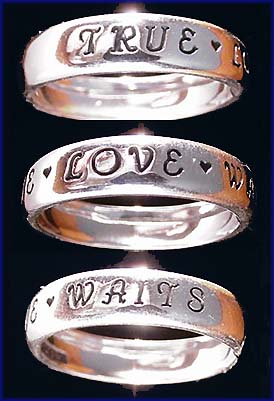 A long, long time ago -- so long ago that it predates the creation of my tmatt.net archives -- I wrote a column about the birth of the "True Love Waits" movement, an attempt by the Southern Baptist Convention and conservative Christians in a host of other churches to urge teens and young adults to save sex for marriage.
The lede on that column, however, offered a twist.
A long, long time ago -- so long ago that it predates the creation of my tmatt.net archives -- I wrote a column about the birth of the "True Love Waits" movement, an attempt by the Southern Baptist Convention and conservative Christians in a host of other churches to urge teens and young adults to save sex for marriage.
The lede on that column, however, offered a twist.
Right from the beginning, the movement's leaders found that the biggest obstacle facing church leaders trying to host "True Love Waits" events was not doubt among the youngsters. The problem was that the parents, especially the fathers, were hesitant to stand up in public and take a public vow that they would not have sex outside of marriage. There were, you see, too many divorced people in these evangelical pews, too many people who hesitated to take a public vow that might require them, even in their own hearts and minds, to repent of their actions in the past.
All of this underlined another theme emerging from the divorce age. Young people, especially girls, are much more likely to be sexually active before marriage in homes wracked by divorce and, especially, when their fathers are absent, unfaithful and unloving.
With that in mind, let us turn to a recent New York Times story by Neela Banerjee, entitled "Dancing the Night Away, With a Higher Purpose," which focuses on the ninth annual father-daughter "Purity Ball" at the Broadmoor Hotel in the symbolic city of Colorado Springs, Colo.
Actually, before we read the story itself, let's take a look at the praise for the story over at The Revealer website, which, like GetReligion, looks for the good and bad in mainstream religion-news coverage.
Does the following sentence strike you as a little creepy? "In their floor-length gowns, up-dos and tiaras, the 70 or so young women swept past two harpists and into a gilt-and-brocade dining room at the lavish Broadmoor Hotel, on the arms of their much older male companions." If so, that's either because you're not familiar with the new ritual of father-daughter "purity balls," or maybe because you are. The NYT's Neela Banerjee turns in a modest masterpiece of lifestyle reporting that manages to bring new insight to the much-covered -- so to speak -- subject of the chastity movement. "The graying men in the shadow of their glittering daughters were the true focus of the night," observes Banerjee -- it's the fathers by whom, and maybe for whom, this ball is produced. "Loss tinged many at the ball," she writes, noting the distinctly adult melancholy of the proceedings. And then this strange last line, worthy of Fitzgerald: "But one father took his two young daughters for a walk around the hotel's dark, glassy lake."
You can read very similar reactions over at Salon.com and at "On Faith", the religion opinion site run by Newsweek and the Washington Post. The first sentence by "On Faith" columnist Claire Hoffman says it all:
My oatmeal churned in my stomach this morning as I read the NY Times story about the Purity Ball in Colorado Springs, where evangelical Christian fathers take their young daughters (or daughters-in-law to be) out for an evening of dancing and pledge-making to be godly and protect the girl's virginity.
It's the headline for that piece that really raises the crucial question: "Odd Purity Ball."
Now, the question is whether the New York Times, Salon.com, Newsweek and the Washington Post could imagine a normal, or a not-odd "Purity Ball." What would such an event look like that did not produce creepy feelings and upset stomachs in these newsrooms of power?
Here's the key section of the original Times piece:
... (After) dessert, the 63 men stood and read aloud a covenant "before God to cover my daughter as her authority and protection in the area of purity." The gesture signaled that the fathers would guard their daughters from what evangelicals consider a profoundly corrosive "hook-up culture." The evening, which alternated between homemade Christian rituals and giddy dancing, was a joyous public affirmation of the girls' sexual abstinence until they wed.
Yet the graying men in the shadow of their glittering daughters were the true focus of the night. To ensure their daughters' purity, they were asked to set an example and to hew to evangelical ideals in a society they say tempts them as much as it does their daughters.
"It's also good for me," said Terry Lee, 54, who attended the ball for a second year, this time with his youngest daughter, Rachel, 16. "It inspires me to be spiritual and moral in turn. If I'm holding them to such high standards, you can be sure I won't be cheating on their mother."
 One question: Why say that the banquet is about "evangelical ideals," as opposed to some basic doctrines common to other churches and other faiths? Is this a matter of cultural style?
One question: Why say that the banquet is about "evangelical ideals," as opposed to some basic doctrines common to other churches and other faiths? Is this a matter of cultural style?
Here, however, is the fact paragraph at the heart of the debate that must be covered:
Recent studies have suggested that close relationships between fathers and daughters can reduce the risk of early sexual activity among girls and teenage pregnancy. But studies have also shown that most teenagers who say they will remain abstinent, like those at the ball, end up having sex before marriage, and they are far less likely to use condoms than their peers.
The argument is not over the facts in that paragraph. The argument is over two things, the statistics behind the word "most" in the statement about the impact of these events on premarital sex, and the impact of various forms of sex education in general.
Let me stress that this is not the topic we will be discussing in the "comments pages," unless you are the rare comment-button clicker who can address the news coverage of those topics without ripping the beliefs of other people.
No, I am more interested in knowing precisely why GetReligion readers think that the images and ideas in this story create such angst. Why, precisely, is this event so "creepy"? While the Times story is solid and well-reported, it does take us once again into that world of neo-National Geographic coverage of the strange and alien tribe called megachurch evangelical Christians. Why end the story with that "dark, glassy lake"?
At this point, in terms of news coverage, is the mere advocacy of traditional religious teachings against sex outside of marriage a ticket to media mockery? Let me stress that I do not believe that the original Times piece has to be interpreted in that way. But the reactions to it are fascinating, to say the least. As a journalist, they kind of creep me out.
